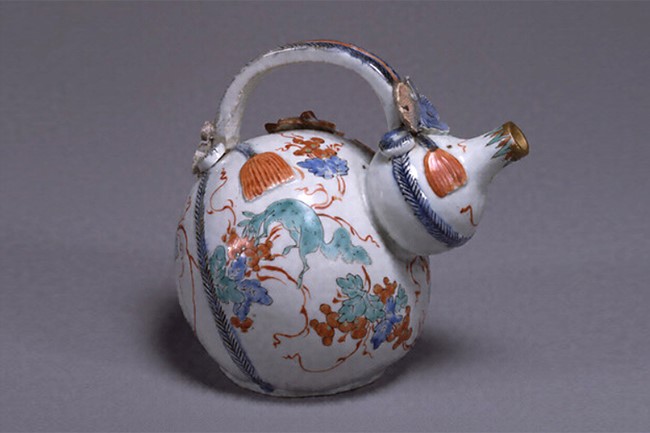
I am sorry for the title a little alien to the graceful realm of Kakiemon-style ceramic art. This title is the phrase used in describing ‘Iroe-Budo-Risu-mon-Saketsugi’, a sort of ewer created in Kakiemon-style.
The Japanese name of the ewer means ‘Gourd shaped wine ewer decorated with grapes and squirrel in overglaze enamels’ in the first place. It is literally a gourd shaped ewer with a handle, which is often featured as a typical work of Kakiemon-style ceramics in overglaze enamels. And what decorates the eccentric shape are the grape branch abundant in fruit and a squirrel a bit unlike one.
A phrase used in describing this strange design is “Restrain by martial arts”. It is explained that in Edo era, when many pieces of Kakiemon-style ceramic art in overglaze enamels were produced, the design of grape and squirrel was accepted with this phrase.
Actually, this grapes-and-squirrel design is used not only for ceramics but also for lacquer craftworks or a sword-guard of Japanese sword. The word ‘martial’ seems to be suitable for swords, but rather a bit unsuitable for Kakiemon-style ewers, doesn’t it?
Here is the image of the gourd shaped wine ewer decorated with grapes and squirrel in overglazed enamel in Kakiemon-style. Grapes laden with fruit are on it. Don’t argue whether its color is appropriate for a grape or not because this is the work in Kakiemon-style where they are good at switching colors. As for squirrel, …umm, is this one? A little different from ones we commonly bring to mind… I think it is rather like a fox…
Let me not complain about the picture here and make it out as grapes and squirrel. Even so, the design still seems strange. I could say it would be easier to accept if this is a combination of squirrel and acorns.
As a matter of fact, this combination is an auspicious omens motif of Chinese origin. Grapes bear numerous fruit; and squirrels, the other motif animal also bear many young. Both of them had got adopted in China frequently, being considered to be fitting for a design of auspiciousness as each motif symbolized the prosperity from generation to generation.
For Chinese people this kind of auspicious motifs are very important, and various designs were used for them. Among them is the Chinese character “福” (FUKU which means ‘happiness’) as the plainest one. “蝙蝠”(KOUMORI which means ‘a bat’) including the character “蝠”(another character whose pronunciation is FUKU, just the same as “福” ) makes a bat an animal symbolizing happiness.
The porcelain of Hizen (old name for a part of Saga prefecture, including Arita) was produced as an alternative for Chinese porcelain. Kakiemon-style ceramic art in overglaze enamels appeared among the Hizen porcelain exported to Europe in the place of cancelled Chinese porcelain. Naturally, the motifs of Chinese origin were adopted. Among Japanese people Grapes and squirrel motif seems to have been accepted as a design, whereas it seems to have been hard to accept a bat as a lucky symbol.
Even so, it appears that Japanese at that time did not quite get the point of what the motif really meant. Consequently, they strained the name of it into a pun of “Restrain by Martial Arts”. It has made the matter even more complicated for us modern Japanese.
In Japanese language,
‘Restrain’ means “律す” 【pronounced RISSU, and a squirrel (栗鼠) is pronounced RISU】, and ‘Martial Arts’ means “武道” 【pronounced BUDO, and grapes (葡萄) are also pronounced BUDO】.



